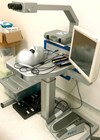Trainee’s perspective
I remember my first day as an ST1 at Moorfields Eye Hospital in Croydon. I was in theatre for a cataract list, and the challenges were numerous. From draping to hydrating the wound, it was all completely new territory for me. My outstanding consultants and experienced theatre team took me under their wing and provided me with the opportunity to learn cataract surgery in a wonderfully supportive environment. I would like to share what excellent teamwork, successful supervision, and a drive to learn can achieve.

First independent case, trainer Tjebo Heeren.
From 0 to 1
Cataract surgery was an incredibly steep learning curve. Not only was the surgery completely new, but even the basics such as theory, terminology, and simple bimanual ability had to be learned. I began by reading the eBook, Phacoemulsification Surgery [1]. This provided me with the language needed to communicate with my trainers, and an understanding of the whys and hows of cataract surgery. I supplemented my theatre sessions with the Eyesi simulator, focusing on challenging steps or those I would expect to encounter next.
I learned cataract surgery with the following steps: capsulorhexis with forceps, divide and conquer, and bimanual I/A. I did not deviate from this until I was able to perform cases consistently. The flexibility of my trainers to accommodate my preferences allowed me to stay consistent with my approach. I was never rushed in theatre, and I cannot thank the patience of my theatre team and supervisors enough for this. At three months, I completed my first full case which we celebrated as a team.

Case 302, trainer Pei-Fen Lin.
From 1 to 100
Although I had now completed my first case, my learning had just begun. I was timetabled in for two cataract lists per week and was given the opportunity to perform 2–3 cases per list. I recorded and reviewed all of my cases. I would take learning points from the recordings and focus on them during my next theatre sessions. Whenever I struggled with something, I would discuss it with my trainers, who were always happy to explain it to me using diagrams or by demonstrating the technique during a case. I completed my ST1 year with 100 cases.
From 100 to 300
As I started my ST2 year, I focused on safety and efficiency of movement, which gradually improved my speed and refined my technique. I still had two timetabled cataract lists but was now able to do three cases per list. My supervised lists allowed me to learn new techniques and instruments in a safe environment. I felt my trainers struck the perfect balance between offering guidance and providing new opportunities and challenges. During this period, I learned chopping, pupil expansion devices, intumescent white cataract management and co-axial I/A.
The expanded surgical repertoire and new techniques allowed me to tackle more challenging cases, employ strategies to navigate difficult situations, and ultimately increase my surgical numbers. Mid-way through ST2, as my trainers became more confident in my ability, I was offered an opportunity to cover a list independently. It was on this list that I completed my 300th cataract surgery with my wonderful theatre team. Again, we celebrated our achievement together.

First independent list.

Case 608, trainer Pei-Fen Lin.
Learning from complications
During my ST2 year, I had my first posterior capsular rupture (PCR). Recognising that complications are an inevitable part of every surgeon’s journey, I took this as an important learning opportunity. I reviewed the recording multiple times and discussed the key learning points with my trainer. This provided me with insights into optimising complication management and how to prevent another PCR from occurring due to the same reason. I closely followed up the patient, and thankfully, they had good outcomes in the end. I understand that becoming a truly independent surgeon means not only reducing complications but also being able to manage them effectively when they occur. This experience highlighted that I still have much to learn in this area.
From 300 to 600
During this period, my timetabled list reduced to one cataract list only, but in addition to this I was offered more independent lists. I was performing 5–7 cases per list. This was only possible due to the encouragement of my trainers, theatre team, and the consultants’ generosity in supervising my lists whilst in clinic. These lists were invaluable in teaching me non-technical skills such as surgical planning, theatre flow and leadership. Operating without the psychological safety net of a supervisor encouraged problem solving and lateral thinking during surgery to tackle tricky situations. As I became more practised, I increased the number of cases on my lists and incorporated more challenging cases, such as medium pupils and toric lenses. Truly complex cases I only performed on consultant-supervised lists, where I was able to continue learning from new challenges with my trainers. I completed my 600th case in my last week as an ST2 with my Croydon team feeling bittersweet.
Reaching 600 cataract surgeries as an ST2 was only made possible by the unwavering support of my colleagues. This milestone was achieved through fantastic teamwork, supportive role models, and the eagerness to celebrate every success both big and small. If someone were to ask: how did I achieve 600 cataract surgeries as an ST2? My answer would be, I didn’t, we as a team did.

Trainer Josef Huemer.

Trainer Tjebo Heeren.
Trainer’s perspective
Training a cataract surgeon requires not only technical proficiency but also the creation of a collaborative and psychologically safe environment. The process involves a multidisciplinary team, including trainers, clinical staff, and administrators, all of whom play a crucial role in supporting the trainee’s development toward surgical competence.
For me, teaching cataract surgery is akin to performing remote surgery verbally. Rather than demonstrating techniques, I focus on coaching and offering precise feedback during the procedure. I have had the privilege of working with a highly skilled trainee who not only possesses technical aptitude but also responds well to feedback, reflecting on her performance and improving continuously. In combination this enabled her to complete her first case after three months, and progressed quickly to 100 cases within ST1.
The approach I adopt in training is heavily influenced by my own mentors, who focused on fostering a safe learning environment. My trainers emphasised both patient safety and my psychological safety, ensuring that they would intervene when necessary to prevent errors, while simultaneously building my confidence by gradually increasing my responsibilities. This balance of trust and supervision allowed me to develop as a surgeon. Today, I strive to replicate this approach, ensuring my trainees know they have the freedom to learn and grow, with the reassurance that I will support them if challenges arise. I do find myself using idioms my own teachers used to whisper across the microscope: “That’s an interesting approach, may I?”
A fundamental principle I follow in teaching surgical skills is maintaining consistency and simplicity in instruction. Breaking down steps and maintaining a consistent approach, I insisted on building good habits before speed and style. I encourage trainees to avoid over analysing the potential difficulty of a case, minimising unnecessary stress and promoting smoother execution. I find myself saying in the theatre “shoulders down,” and “let go of the instrument or you will have cramps!”
Of course, cataract surgery training encompasses more than mastering the procedure itself. It involves managing the entire surgical process, from organising the case list to understanding each patient’s specific needs. The arrangement I establish with my trainees is straightforward: they are responsible for managing the surgical list, and in return, I focus on teaching them the surgical techniques. This collaboration ensures that the theatre runs efficiently, with both the trainee and I fully aware of our respective roles.
Balancing the needs of surgical training, theatre time, and hospital capacity is a continual challenge, but by carefully coordinating the list to ensure that theatre staff are able to complete their duties on time, our team in turn provides a pivotal role in a trainee’s progression. Their observations and feedback are invaluable in helping trainers adjust our teaching approach to better support individual trainees. In this case, the confidence, agreement and support of the theatre staff have been instrumental in supporting her independent cataract lists at ST2, helping to achieve the impressive 608 case numbers.
Lastly, I insist on celebrating milestones together as a team. From completing a first case, first 100 cases, and especially after the first posterior capsule tear. After all, you are not a real cataract surgeon until your first PC tear!
Ultimately, the training of cataract surgeons is a collective effort. From the initial steps of the trainee to their eventual mastery of the procedure, the entire team plays a pivotal role – it truly takes a village.
Reference
1. Sullivan P, Benjamin L, Little B. Phacoemulsification Surgery: An Interactive Multimedia Atlas for Ophthalmology Trainees, Second Edn.
www.eyelearning.co.uk; 2018.
Declaration of competing interests: None declared.














